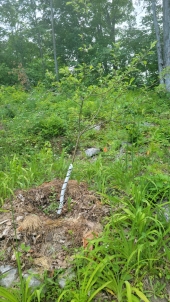Being in Portugal, on a sunny garrigue-like corner, bay leaf, fig and citrus trees also come to mind. Given it is a small plot though, two small trees might be enough.
Where do prevailing winds and rain come from ? If you plan a hedge, you would set it so it does not block the rain from your land.
Also, is the area leveled or sloping ? A little swale, rock alignment or compost trench cut downhill the trees or shrubs might help them, I would expect strawberries to be planted near a compost pit or water feature though - it might be too dry elsewhere for them.
You might throw some chickpeas or your favorite legume in there also, among aromatic and edible perennials (sea orache in the sun, sea kale in tree shadow ? depending on what you like)
Some trees or shrubs fix nitrogen, make good hedges, withstand drought, pruning and are edible too (... but are also quite invasive and sometimes spiny ...), perhaps Eleagnus or sea buckthorn ? Depending on space and the patience you have to trim them.
Have a nice day,











